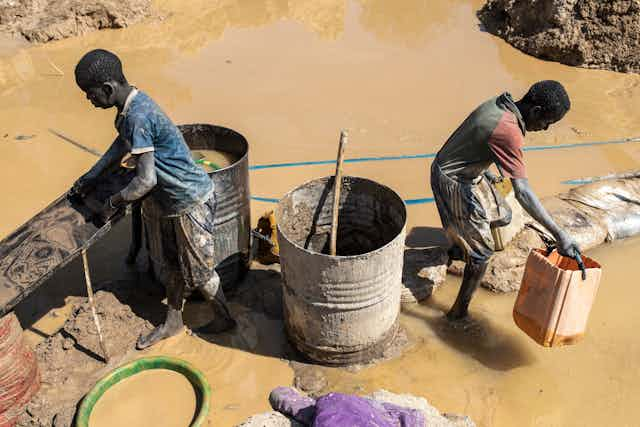“Do not fish in these waters.” “Contains high levels of mercury.”
These warnings are shown at thousands of lakes and rivers globally, as well as on numerous fish products.
But eating mercury-laden fish is not the only source of mercury exposure. Even more dangerous is the inhalation of mercury vapours, which are released as mercury is used in the extraction of another trace element – gold. Miners inhaling mercury vapour can experience the same toxic effects as people eating mercury-laden food: limb tremors, blurred vision, loss of limb functionality, and even death. Globally, between 10 million and 19 million people work in artisanal and small-scale gold mining.
I have studied the impact of mercury on the environment globally for the past eight years. My recent research has found an effective way to reduce mercury emissions from artisanal and small-scale gold mining in Senegal through education and equipment distribution.
We conducted educational sessions on the dangers of mercury and on the use of equipment to reduce mercury emissions and exposure. The sessions were held by trusted community members, in local languages, using simple graphics. Communities also received equipment: retorts (mercury-capture devices) produced by local metalworkers using locally available materials. They made the items available for purchase in local stores.
Mercury use in artisanal and small-scale gold mining
Artisanal and small-scale gold mining produces about 20% of all the gold sold on the world market. The process is far from environmentally friendly. Large areas of forest are cleared to make way for mining equipment. Soil or sediment is extracted from pits or rivers. And then mercury is mixed into the sediment.
Mercury is used in the extraction of gold because it is cheap, easy to obtain, and efficient at separating gold. It forms a coating around the gold, creating a mercury-gold amalgam. This amalgam is then burned, leaving behind gold that can be sold for large profits. In the process, huge amounts of mercury are released into the atmosphere.
Artisanal and small-scale gold mining is the largest source of mercury pollution globally, emitting more mercury than coal combustion. It occurs in over 70 countries, most of them in sub-Saharan Africa, southeast Asia and South America. The United Nations Environmental Programme’s Minamata Convention on Mercury went into effect in 2017 to reduce the production, trade and use of mercury globally. Article 7 specifically deals with mercury in artisanal and small-scale gold mining.
Read more: Artisanal gold mining in South Africa is out of control. Mistakes that got it here
Strategies to reduce mercury emissions from gold mining
Despite the Convention, there has been little success in reducing mercury use and emissions from artisanal and small-scale gold mining. Many researchers and organisations have sought to train people about the dangers of mercury, or have introduced mercury-free technologies. These interventions sometimes succeed in reducing mercury use at first, but new practices don’t always continue.
Public health interventions teach us that knowledge does not always lead to behaviour change. For example, we know that smoking is dangerous, yet many people continue to smoke. And mercury-free technologies are often expensive, produced with materials that cannot be sourced locally, and highly technical.
Intervention in Senegal
In a recent study, I worked with collaborators in Senegal to reduce the emissions of mercury from artisanal and small-scale gold mining. Together, we paired an educational campaign with equipment distribution over the course of six months. Through surveys before and after the intervention, we found that it was highly successful in increasing knowledge about the dangers of mercury and increasing the use of improved technologies.
Trusted community members conducted educational sessions in local languages. Visuals were created with feedback from local Senegalese collaborators to ensure cultural appropriateness. Local people were trained to present the information to miners and community members and to answer questions. They were paid for attending this training.
Trainers then led formal sessions to discuss these topics. Additional informal educational sessions happened over tea in their communities in local languages. The sessions emphasised the dangers of mercury and advised on the use of retorts and personal protective equipment to reduce mercury emissions and exposure. Village chiefs, imams, elected officials, miners, vendors, women’s groups, and youth were all targeted for the educational sessions. Information was also spread through local radio, an effective technique for reaching a wider audience in Senegal.
Equipment was distributed to local stores, making the items available for purchase. The goal was to increase access to equipment that can reduce mercury exposure, while still requiring people to pay for it, thereby reducing reliance on outside organisations for continuity of the programme.
Equipment distribution focused on retorts, devices that act like a lid on a pot. In traditional methods over open flames, the mercury-gold amalgam releases mercury directly into the air. In a retort, the mercury that is released condenses on the retort lid and is passed down a tube to a bucket of water, where it can be collected. This reduces the emission of mercury into the air and the mercury can be reused.
Retorts were made using locally available equipment by a local metal worker. The design attended to the needs of miners and incorporated their feedback. The first set of equipment was provided free of charge to stores, and they purchased equipment restock with the profits from selling the first set. Retorts were sold for 15,000 CFA (about US$24.70).
Read more: Ghana's artisanal miners are a law unto themselves: involving communities can help fix the problem
Implications of this intervention
Artisanal gold mining is an important livelihood for many people in Senegal and globally. Given the dangers of mercury toxicity, it’s necessary to reduce the high exposure of miners and their communities. Our study provides one mechanism to achieve this.
It has seen a positive reaction, suggesting that similar interventions could be effective in other countries with artisanal and small-scale gold mining.

